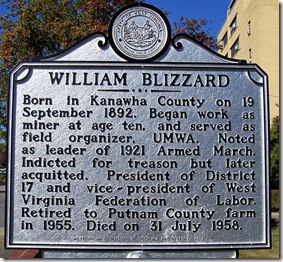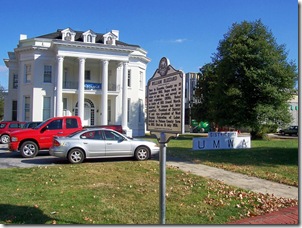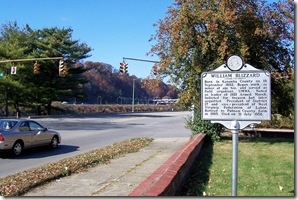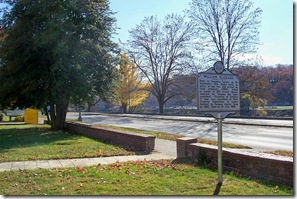Marker Text: Born in Kanawha County on 19 September 1892. Began work as miner at age ten, and served as field organizer, UMWA. Noted as leader of 1921 Armed March. Indicted for treason but later acquitted. President of District 17 and vice-president of West Virginia Federation of Labor. Retired to Putnam County farm in 1955. Died on 31 July 1958.
Location: In front of UMWA District 17 headquarters, 1300 Kanawha Boulevard East, Charleston, WV. Erected by the West Virginia Division of Archives and History in 2007.
West Virginia coal miners of the early part of the 20th century often looked to a brash young man named William Blizzard for leadership. Blizzard was an outspoken leader whose name is associated with some of the bloodiest confrontations of West Virginia's mine wars. William Blizzard achieved national prominence as a young man of 29 after the Battle of Blair Mountain, in which miners fought a pitched battle against sheriff's deputies and armed guards.
Marker in front of UMWA District 17 headquarters in Charleston, WV. Click any photo to enlarge.
Unionist William ‘‘Bill’’ Blizzard was born September 19, 1892, the son of Timothy Blizzard and activist Sarah Rebecca ‘‘Mother’’ Blizzard. He became one of West Virginia’s most influential and controversial labor leaders of the 20th century. Born in the Cabin Creek district of Kanawha County, Blizzard first became involved with the United Mine Workers of America during the bloody Paint Creek-Cabin Creek strike of 1912–13. During the next decade, he rose from the rank and file along with Frank Keeney and Fred Mooney.
In 1921, Blizzard played a key role in the Miners’ March on Logan County by leading the miners in the front lines of the Battle of Blair Mountain. While District 17 President Keeney and Secretary-treasurer Mooney managed events behind the scenes.
Photo looking west on Kanawha Boulevard.
After the Battle of Blair Mountain, Blizzard was arrested and indicted for treason and murder and was tried in Charles Town, WV. Prosecution and defense attorneys agreed to move the trial to Jefferson County, in the Eastern Panhandle of West Virginia far from the coalfields. Interestingly, Blizzard treason trial was held in the same courthouse where Abolitionist John Brown had been tried and found guilty and later hanged in Charles Town, WV. The prosecution chose to try Blizzard first, believing that the State of West Virginia v. William Blizzard was the strongest of the treason cases. Coal company attorneys composed the prosecution team. Blizzard was defended by T. C. Townsend, former Kanawha County prosecuting attorney who led the defense and Harold Houston.
Ultimately, Blizzard was acquitted of the treason charge, but he still had to face murder charges in Lewisburg and Fayetteville associated with the battle. His first trial on those charges ended in a hung jury with the murder charges being eventually dismissed. However, the District 17 officials had lost favor with UMWA President John L. Lewis and in 1924 Keeney and Mooney were forced to retire. Blizzard remained in the union but lost much of his influence.
Photo taken looking east the Kanawha River is in background across from the Boulevard.
Blizzard's treason trial centered on a discussion of Blizzard’s location during the movement toward Blair Mountain. Prosecution witnesses claimed that Blizzard had shadowed the marchers, periodically requesting reports and issuing orders. The defense presented witnesses claiming that Blizzard had remained in Charleston during the crisis. Questions about the reliability of some prosecution witnesses, as well as Blizzard’s role in convincing the miners to lay down their arms, led the jury to acquit him on the evening of May 27, 1922.
Blizzard returned to prominence in 1931 when he led the UMWA’s struggle against Keeney’s West Virginia Mine Workers Union. Blizzard became a close associate of union leader Van Bittner and together they made the UMWA a powerful political force in West Virginia. In 1945, Blizzard was appointed president of District 17 and served for 10 years. John L. Lewis forced Blizzard to resign after learning of a fistfight between Blizzard and Lewis’s youngest brother, Raymond Lewis. Blizzard died of cancer July 31, 1958, reportedly having come to regret his long association with the Lewis forces inside the UMWA.




No comments:
Post a Comment